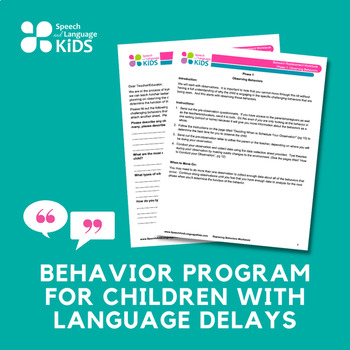Behavior Program for Children with Language Delays - FBA through Therapy
- PDF
Description
Step-by-step program for helping children with language delays who exhibit challenging behaviors. This kit will walk you through replacing those challenging behaviors with communication, even if they are non-speaking or minimally verbal. This program starts with the materials and instructions for conducting a functional behavior assessment and goes all the way through structured behavior and therapy plans that will establish new communication skills and fade out the old challenging behaviors. Perfect for speech-language pathologists, behavior specialists, and teachers.
Why We Focus on Replacing Challenging Behaviors with Communication:
Children who are not able to communicate effectively with those around them often resort to what we call “challenging behaviors” in order to express themselves and get their wants and needs met. Some of those children are very good at making those challenging behaviors work for them but they can interfere with our ability to help them communicate with those around them and participate in daily living activities or school.
We can help these children replace those challenging behaviors with effective communication strategies that will help them communicate their wants and needs without becoming disruptive or destructive. Our job as the speech-language professionals and/or behavior specialists is to take a look at those behaviors and figure out what they are communicating. Then, we can teach the child effective communication strategies that will help reduce the need for the child to engage in those other behaviors. And we can do this even if the child is non-verbal or doesn’t have many language skills yet.
This packet includes everything you need to do just that!
The Steps of the Process:
In order to help a child with challenging behaviors, we need to understand what those behaviors are communicating to us. Then we can make a plan for how to teach them effective communication strategies to replace those behaviors.
This program provides you everything you need to:
- Collect Observations of Behaviors: This occurs during a functional behavior analysis. We start by observing those behaviors and writing down what happens before, during, and after the events.
- Determine the Function of the Behavior: All behavior is communication. We help you determine what each behavior is communicating for that child.
- Choose Replacement Behaviors: This program will also give you ideas for what types of communication can be used to replace the challenging behaviors. We have visual aids and supports for children who are non-speaking or minimally verbal as well.
- Establish Replacement Behaviors: In order to establish these new forms of communication and fade out old behaviors, we provide you with everything you need to get the child's educational team on the same page and teach the new communication strategy. This will include therapy plans for a speech-language pathologist as well as behavior plans for the classroom.
- Generalize Communication Strategies: Once we have taught the new strategy, it's all about encouraging the child to use the new communication strategy instead of using the old challenging behavior. We'll help you step the child into this gradually instead of expecting them to be perfect right away.
What’s Included:
This program includes everything you need:
- Sample Goals
- Data Collection Sheets
- Questionnaires and Letters for Parents and Teachers
- Lesson Plans and Instructions for Every Step of the Process
- Fill-in-the-Blank Behavior Plans and Questionnaires for Team Meetings
- Visual Aids for Teaching Communication Strategies
- Ideas for How to Replace those Challenging Behaviors
This 56-page packet includes everything you need to walk you through identifying the function of challenging behaviors and replacing them with effective communication strategies. Everything is laid out for you and we’ll walk you through the entire process, step-by-step. You’ll find resources for parents and educators for every step of the process so you can keep the whole team on the same page to keep the child moving forward.
Age Range: This packet is perfect for children who are non-verbal or who are using language to communicate (up through the simple sentences level). We find that this often corresponds with ages 1-5 years but older children may benefit from this packet as well if they are in those non-verbal, pre-verbal, or emerging-verbal stages of development.
Follow this kit from front to back and you’ll have everything you need to do the following:
- Gather Information about the child’s behaviors in the natural environment
- Conduct an Effective Observation of the child’s behaviors while altering the environment to test theories
- Identify the Function of the behaviors
- Choose Appropriate Replacement Behaviors that use effective communication strategies to get wants and needs met
- Meet with the child’s team to Create a Behavior Response Plan and Identify Environmental Modifications
- Introduce the New Communication Strategy to the child in a 1:1 session (in the natural environment)
- Help the child’s team carry out the plan to Help the Child Establish the New Strategy
- Help the child Generalize the New Communication Strategy
- Help the child Learn to Wait to get what he has communicated when in the middle of another activity
- Choose New Behaviors to target or identify other areas of need
Who is this For?
- Speech-Language Pathologists and Behavior Specialists: We are often called to lead our educational team when developing plans to support a child's behavior. This kit is specifically designed for you!
- Teachers: While special educators have additional training in the area of behavior that you might not have, you can still use this program to get an idea of how we look at behavior and find ways for children to communicate with words instead of actions.
More (Free) Resources:
For more information about how to help children with communication-based behavior challenges, check out our free blog post and podcast here: https://www.speechandlanguagekids.com/how-to-deal-with-challenging-behaviors-in-the-classroom-and-speech-therapy-room/





